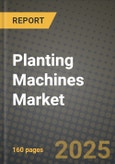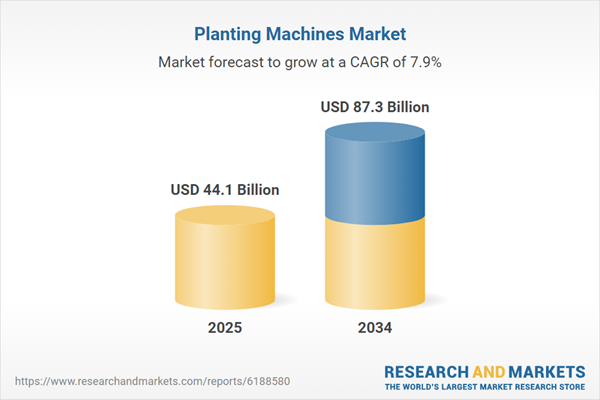Planting Machines Market Overview
The planting machines market is witnessing significant growth as the global agricultural industry moves towards automation and precision farming. These machines, which include seed drills, transplanters, and precision planters, are designed to enhance efficiency, reduce labor dependency, and optimize seed placement for higher crop yields. Increasing population and the growing demand for food are pushing farmers to adopt mechanized solutions that improve productivity and ensure sustainability. Technological advancements, such as GPS-guided planting, variable rate seeding, and AI-driven automation, are further revolutionizing the industry. Governments and agricultural organizations worldwide are promoting the adoption of modern planting technologies through subsidies and awareness programs, ensuring accessibility even in emerging economies. As the demand for high-yield, sustainable farming practices rises, the planting machines market is expected to expand rapidly, driven by a combination of technological innovation and increasing mechanization.The planting machines market experienced a surge in demand due to favorable agricultural policies and growing investment in smart farming technologies. The year saw an increase in the adoption of autonomous and semi-autonomous planting machines, particularly in large-scale farming operations. Precision planting technologies gained traction, with farmers increasingly utilizing AI-powered sensors and real-time data analytics to optimize seed distribution. The integration of IoT-enabled planting machines allowed farmers to monitor and control equipment remotely, improving efficiency and reducing operational costs. Additionally, sustainability remained a key focus, leading to the development of energy-efficient, electric, and hybrid-powered planting machines. In regions affected by labor shortages, such as North America and Europe, robotic planting systems saw significant adoption. Meanwhile, emerging economies in Asia and Africa benefited from government-backed initiatives that encouraged mechanized farming, fueling market growth.
The planting machines market is expected to witness further advancements in automation and connectivity. AI-driven decision-making capabilities will become more prominent, allowing machines to adjust seed depth and spacing in real time based on soil conditions. The integration of 5G technology will enhance remote monitoring and fleet management of planting equipment, ensuring higher efficiency. Sustainability efforts will lead to the expansion of solar-powered and hybrid planting machines, reducing reliance on fossil fuels. Additionally, the push for regenerative agriculture will drive innovations in no-till and minimum-till planting technologies, helping to preserve soil health and biodiversity. Emerging markets, particularly in Latin America and Southeast Asia, will see increased adoption as mechanization becomes more affordable and accessible. The competitive landscape will continue to evolve, with major agricultural equipment manufacturers focusing on strategic collaborations, mergers, and product diversification to strengthen their market position.
Key Insights: Planting Machines Market
- Rise of Autonomous Planting Machines: Self-driving and AI-powered planting machines are gaining popularity, reducing the need for human intervention and improving precision in large-scale farming.
- Integration of IoT and Smart Sensors: The use of IoT-enabled sensors in planting machines allows real-time monitoring of soil conditions, seed placement, and machine performance, enhancing efficiency.
- Adoption of Electric and Hybrid Planting Machines: With increasing sustainability concerns, manufacturers are developing electric and hybrid-powered planting machines to reduce carbon emissions.
- Advancements in Precision Farming: GPS-guided planting and variable rate seeding technologies are improving seed distribution, optimizing yields, and minimizing wastage.
- Expansion in Emerging Markets: Government subsidies and rural mechanization programs are driving the adoption of planting machines in developing regions, boosting agricultural productivity.
- Growing Global Food Demand: The need for higher agricultural output to feed the growing population is driving farmers to adopt advanced planting technologies for increased efficiency.
- Labor Shortages in Agriculture: The declining availability of skilled labor in farming is encouraging mechanization, making planting machines essential for large-scale crop production.
- Technological Advancements in Farming Equipment: Innovations in AI, robotics, and automation are making planting machines more efficient, precise, and user-friendly.
- Government Support and Agricultural Policies: Subsidies, incentives, and awareness programs promoting mechanized farming are accelerating the adoption of planting machines worldwide.
- High Initial Investment Costs: The high cost of advanced planting machines remains a barrier for small and medium-sized farmers, limiting adoption in certain regions.
Planting Machines Market Segmentation
By Machinery
- Seed Drill
- Planters
- Air Seeders
- Other Machinery
By Type
- Planting Machinery
- Fertilizing Machinery
By Design
- Automatic
- Mechanical
Key Companies Analysed
- AGCO Corporation
- Bourgault Industries Ltd.
- Bucher Industries AG
- CLAAS KGaA mbH
- CNH Industrial N.V.
- Deere & Company
- ISEKI & Co. Ltd.
- Kubota Corporation
- Mahindra & Mahindra Ltd.
- Yanmar Holdings Co. Ltd.
- Kasco Manufacturing Co. Inc.
- Davimac Pty. Ltd.
- Kinze Manufacturing Inc.
- Horsch Maschinen GmbH
- Gaspardo
- Great Plains Manufacturing Inc.
- Kverneland Group
- Monosem Inc.
- Maschio Gaspardo S.p.A.
- Amity Technology
- Landoll Corporation
- Stanhay
- Hardi International
- Grimme Group
- Gomselmash
- Accord
- KUHN Group
- Salford Group
- Miedema
- Sukup Manufacturing Co.
- MaterMacc
- Stara S/A Indústria de Implementos Agrícolas
- Rabe
- Lemken GmbH & Co. KG
- Pöttinger Landtechnik GmbH
- Farmet a.s.
- Strojirna Novotny s.r.o.
- DAWN Equipment Company
Planting Machines Market Analytics
The report employs rigorous tools, including Porter’s Five Forces, value chain mapping, and scenario-based modeling, to assess supply-demand dynamics. Cross-sector influences from parent, derived, and substitute markets are evaluated to identify risks and opportunities. Trade and pricing analytics provide an up-to-date view of international flows, including leading exporters, importers, and regional price trends.Macroeconomic indicators, policy frameworks such as carbon pricing and energy security strategies, and evolving consumer behavior are considered in forecasting scenarios. Recent deal flows, partnerships, and technology innovations are incorporated to assess their impact on future market performance.
Planting Machines Market Competitive Intelligence
The competitive landscape is mapped through proprietary frameworks, profiling leading companies with details on business models, product portfolios, financial performance, and strategic initiatives. Key developments such as mergers & acquisitions, technology collaborations, investment inflows, and regional expansions are analyzed for their competitive impact. The report also identifies emerging players and innovative startups contributing to market disruption.Regional insights highlight the most promising investment destinations, regulatory landscapes, and evolving partnerships across energy and industrial corridors.
Countries Covered
- North America - Planting Machines market data and outlook to 2034
- United States
- Canada
- Mexico
- Europe - Planting Machines market data and outlook to 2034
- Germany
- United Kingdom
- France
- Italy
- Spain
- BeNeLux
- Russia
- Sweden
- Asia-Pacific - Planting Machines market data and outlook to 2034
- China
- Japan
- India
- South Korea
- Australia
- Indonesia
- Malaysia
- Vietnam
- Middle East and Africa - Planting Machines market data and outlook to 2034
- Saudi Arabia
- South Africa
- Iran
- UAE
- Egypt
- South and Central America - Planting Machines market data and outlook to 2034
- Brazil
- Argentina
- Chile
- Peru
Research Methodology
This study combines primary inputs from industry experts across the Planting Machines value chain with secondary data from associations, government publications, trade databases, and company disclosures. Proprietary modeling techniques, including data triangulation, statistical correlation, and scenario planning, are applied to deliver reliable market sizing and forecasting.Key Questions Addressed
- What is the current and forecast market size of the Planting Machines industry at global, regional, and country levels?
- Which types, applications, and technologies present the highest growth potential?
- How are supply chains adapting to geopolitical and economic shocks?
- What role do policy frameworks, trade flows, and sustainability targets play in shaping demand?
- Who are the leading players, and how are their strategies evolving in the face of global uncertainty?
- Which regional “hotspots” and customer segments will outpace the market, and what go-to-market and partnership models best support entry and expansion?
- Where are the most investable opportunities - across technology roadmaps, sustainability-linked innovation, and M&A - and what is the best segment to invest over the next 3-5 years?
Your Key Takeaways from the Planting Machines Market Report
- Global Planting Machines market size and growth projections (CAGR), 2024-2034
- Impact of Russia-Ukraine, Israel-Palestine, and Hamas conflicts on Planting Machines trade, costs, and supply chains
- Planting Machines market size, share, and outlook across 5 regions and 27 countries, 2023-2034
- Planting Machines market size, CAGR, and market share of key products, applications, and end-user verticals, 2023-2034
- Short- and long-term Planting Machines market trends, drivers, restraints, and opportunities
- Porter’s Five Forces analysis, technological developments, and Planting Machines supply chain analysis
- Planting Machines trade analysis, Planting Machines market price analysis, and Planting Machines supply/demand dynamics
- Profiles of 5 leading companies - overview, key strategies, financials, and products
- Latest Planting Machines market news and developments
Additional Support
With the purchase of this report, you will receive:- An updated PDF report and an MS Excel data workbook containing all market tables and figures for easy analysis.
- 7-day post-sale analyst support for clarifications and in-scope supplementary data, ensuring the deliverable aligns precisely with your requirements.
- Complimentary report update to incorporate the latest available data and the impact of recent market developments.
This product will be delivered within 1-3 business days.
Table of Contents
Companies Mentioned
- AGCO Corporation
- Bourgault Industries Ltd.
- Bucher Industries AG
- CLAAS KGaA mbH
- CNH Industrial N.V.
- Deere & Company
- ISEKI & Co. Ltd.
- Kubota Corporation
- Mahindra & Mahindra Ltd.
- Yanmar Holdings Co. Ltd.
- Kasco Manufacturing Co. Inc.
- Davimac Pty. Ltd.
- Kinze Manufacturing Inc.
- Horsch Maschinen GmbH
- Gaspardo
- Great Plains Manufacturing Inc.
- Kverneland Group
- Monosem Inc.
- Maschio Gaspardo S.p.A.
- Amity Technology
- Landoll Corporation
- Stanhay
- Hardi International
- Grimme Group
- Gomselmash
- Accord
- KUHN Group
- Salford Group
- Miedema
- Sukup Manufacturing Co.
- MaterMacc
- Stara S/A Indústria de Implementos Agrícolas
- Rabe
- Lemken GmbH & Co. KG
- Pöttinger Landtechnik GmbH
- Farmet a.s.
- Strojirna Novotny s.r.o.
- DAWN Equipment Company
Table Information
| Report Attribute | Details |
|---|---|
| No. of Pages | 160 |
| Published | October 2025 |
| Forecast Period | 2025 - 2034 |
| Estimated Market Value ( USD | $ 44.1 Billion |
| Forecasted Market Value ( USD | $ 87.3 Billion |
| Compound Annual Growth Rate | 7.8% |
| Regions Covered | Global |
| No. of Companies Mentioned | 38 |









